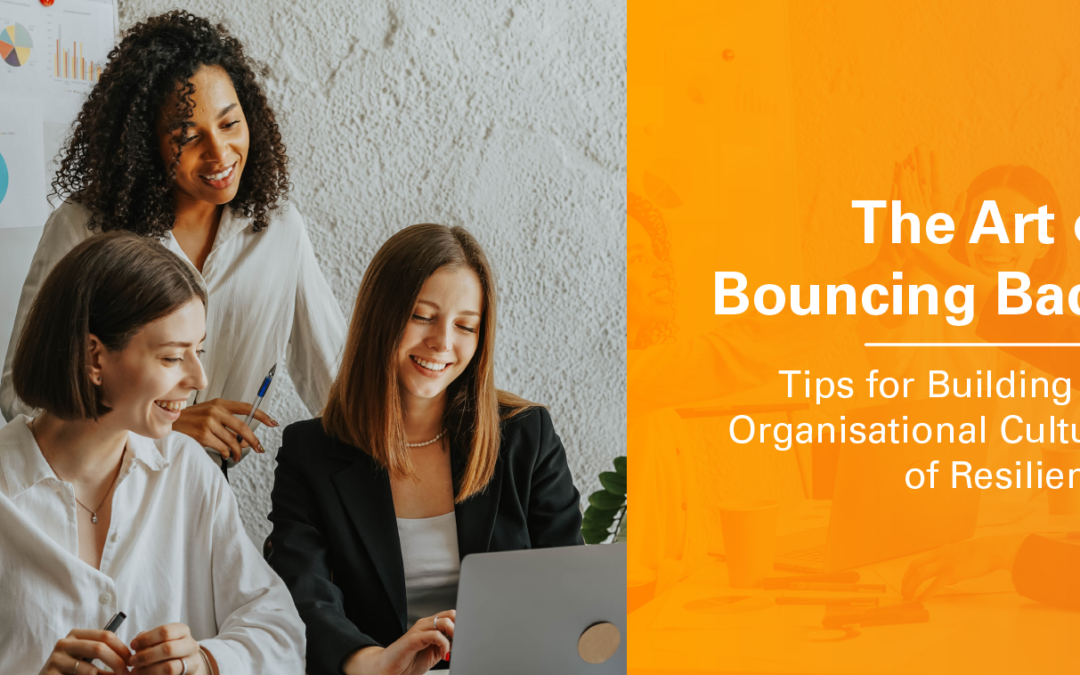5 TIPS FOR BUILDING AN ORGANISATIONAL CULTURE OF RESILIENCE
Dealing with change has always been an important part of life and business. If the last couple of years have taught us anything, it’s that we need to be prepared for the impact that change can have.
The key to not only being prepared for adversities and change, but prospering through them, is resilience. While resilience is often thought of as an individual trait, it’s also possible to build an organisational culture of resilience.
So, what exactly is resilience? Resilience is often seen as the art of “bouncing back,” but it’s actually a lot more than that. Resilience is about growing and learning despite facing adversities. It’s a skill that needs to be developed over time that allows you to learn from the past and get better at handling change and stress.
Just as individuals can learn to develop personal traits of resilience, so too can organisations develop a culture of resilience. But what does a culture of resilience look like?
Put simply, a resilient organisation is one that adapts quickly and efficiently in the face of changes, problems, or circumstances. These organisations don’t just react to changing circumstances – they also learn from them, and proactively prevent the same problems from happening in the future.
One of the most important factors driving organisational culture is strong leadership. Resilient cultures begin with engaged leaders that understand and support employees.
So, how can HR leaders work to foster an organisational culture of resilience?
1. Learn from past failures
Being able to adapt and grow through adverse change is one of the key traits of a resilient organisation. You won’t always be successful, but if you’re able to leverage the experience gained through failure, you can enhance your organisation’s resilience to future change. If something fails, ask yourself: What went wrong here? What could be done better next time?
Encourage managers to have debriefing sessions with their team after a challenging situation or stressful event. These sessions should focus on reflecting on both the positive and negative outcomes of the experience. This allows teams to learn from their experience and tackle obstacles differently in the future, all in a safe space.
2. Encourage transparency and communication
It’s important to create a two-way street of transparency and communication where employees feel comfortable to express their views, and where managers can provide ongoing feedback. This allows more room for growth at both an individual and organisational level.
Encourage managers to have open-ended conversations with employees and collect their thoughts on topics like engagement, leadership effectiveness, and more. On top of this, provide more opportunities for feedback, in order to create a culture that encourages a continuous flow of constructive feedback from managers and peers. It’s also important that this feedback is addressed.
While it’s not feasible to implement everything suggested, it’s vital to acknowledge that the feedback has been taken on board, so employees feel heard and valued.
3. Provide a psychologically safe work environment
Creating a psychologically safe work environment is vital in more ways than one. Not only will it lead to improved worker engagement, enhanced productivity, increased innovation and organisational sustainability, but it will also contribute to building an organisational culture of resilience.
It’s important to address areas within your workplace that could impact an employee’s mental health, including ineffective communication, excessive pressure, workloads, workplace relationships, bullying, fairness, career development and more.
In many cases, controlling psychological risks within an organisation will require the redesign of work processes and role requirements. You can also help manage risks by providing access to, or information about, support services, as well as improving workplace culture through a range of integrated programs such as employee assistance programs.
4. Show employee appreciation
This tip comes up in almost every HR management tip list you’ll ever read, and with good reason. When it comes to resilience, employees that feel valued and appreciated are more likely to bounce back from adversities and grow within your organisation. One of the most effective methods for valuing employees that HR can enable is implementing employee recognition and reward programs. You can read some of our top tips for showing employee appreciation here.
5. Teach employees skills to build their personal resilience
To create a culture of resilience in your organisation, you need to help your people become more resilient. Because, at the end of the day, your organisation is nothing without your people.
Few people start out resilient. In fact, less than half of us are naturally resilient. The good news, though, is that resilience can be taught and learned.
One of the most effective ways to help employees to strengthen their resilience is to teach them skills that help them respond better to stress. There are a number of different tools you can give them to do this.
You could teach them mindfulness exercises such as deep breathing, meditation and journaling. You could encourage them to take care of their health through regular exercise and nutrition. You could also teach your people how to apply the sciences of positive psychology in order to increase positive emotions on a daily basis. Or we could do the heavy lifting for you.
Our white-labelled corporate wellbeing platforms incorporate a range of tools and activities that will help you support your employees to manage stress, strengthen their resilience, and boost their overall wellbeing. Learn more about our solutions or chat to us about how we can help you.
Read more:

Gold for Springday at this year’s HRD Awards
Wellbeing Gateway by Springday has been awarded Gold in the Corporate Health and Wellbeing category, at the prestigious Human Resources Director (HRD) Best HR Service Providers in Australia and New Zealand Service Provider Awards 2024.

Health benefits of mastering movement
As the weather begins to warm, it’s even more incentive to get moving.

Empower your workplace with resilience
Resilience, defined as the ability to recover and thrive in the face of adversity, is a critical trait for both individuals and organisations.







